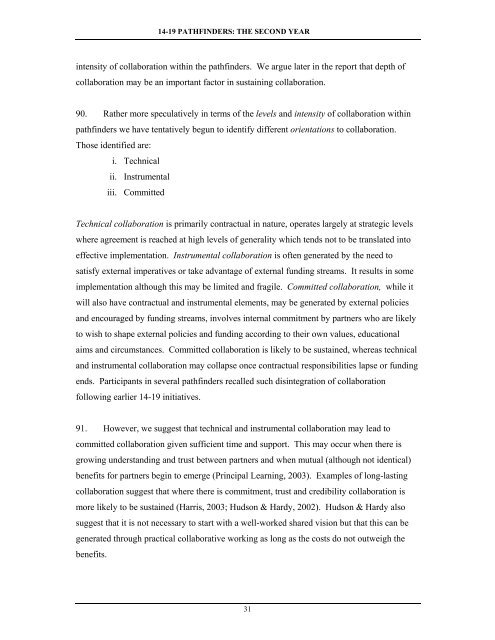Collaborative Approaches to 14-19 Provision - Communities and ...
Collaborative Approaches to 14-19 Provision - Communities and ...
Collaborative Approaches to 14-19 Provision - Communities and ...
- No tags were found...
Create successful ePaper yourself
Turn your PDF publications into a flip-book with our unique Google optimized e-Paper software.
<strong>14</strong>-<strong>19</strong> PATHFINDERS: THE SECOND YEARintensity of collaboration within the pathfinders. We argue later in the report that depth ofcollaboration may be an important fac<strong>to</strong>r in sustaining collaboration.90. Rather more speculatively in terms of the levels <strong>and</strong> intensity of collaboration withinpathfinders we have tentatively begun <strong>to</strong> identify different orientations <strong>to</strong> collaboration.Those identified are:i. Technicalii. Instrumentaliii. CommittedTechnical collaboration is primarily contractual in nature, operates largely at strategic levelswhere agreement is reached at high levels of generality which tends not <strong>to</strong> be translated in<strong>to</strong>effective implementation. Instrumental collaboration is often generated by the need <strong>to</strong>satisfy external imperatives or take advantage of external funding streams. It results in someimplementation although this may be limited <strong>and</strong> fragile. Committed collaboration, while itwill also have contractual <strong>and</strong> instrumental elements, may be generated by external policies<strong>and</strong> encouraged by funding streams, involves internal commitment by partners who are likely<strong>to</strong> wish <strong>to</strong> shape external policies <strong>and</strong> funding according <strong>to</strong> their own values, educationalaims <strong>and</strong> circumstances. Committed collaboration is likely <strong>to</strong> be sustained, whereas technical<strong>and</strong> instrumental collaboration may collapse once contractual responsibilities lapse or fundingends. Participants in several pathfinders recalled such disintegration of collaborationfollowing earlier <strong>14</strong>-<strong>19</strong> initiatives.91. However, we suggest that technical <strong>and</strong> instrumental collaboration may lead <strong>to</strong>committed collaboration given sufficient time <strong>and</strong> support. This may occur when there isgrowing underst<strong>and</strong>ing <strong>and</strong> trust between partners <strong>and</strong> when mutual (although not identical)benefits for partners begin <strong>to</strong> emerge (Principal Learning, 2003). Examples of long-lastingcollaboration suggest that where there is commitment, trust <strong>and</strong> credibility collaboration ismore likely <strong>to</strong> be sustained (Harris, 2003; Hudson & Hardy, 2002). Hudson & Hardy alsosuggest that it is not necessary <strong>to</strong> start with a well-worked shared vision but that this can begenerated through practical collaborative working as long as the costs do not outweigh thebenefits.31
















